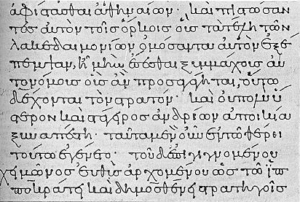This is RPG-ology #37: It’s Greek to Me, for December 2020.
Decades ago I was running original Advanced Dungeons & Dragons for a burgeoning group that included a number of experienced players. Experienced players of course bring knowledge from their other games, their other Dungeon Masters. I have twice had the complication that one of the players at the table was familiar with a module I had decided to run, and multiple times had them recognize a magic item from the books—but that’s a different problem.

Magic items in the game can be rather complicated. Find one, but you probably don’t know what it does or how to make it do that. Swords and weapons seem simple, but often have hidden powers that can be activated with the right command word or the right combat situation. Of course, such objects often have inscriptions or decorations, something that might hint or outright tell the new owner what to do with it. On the other hand, there’s no guarantee that the old owner didn’t write something misleading.
In any case, my players began asking for just about every object they found, from the leather armor worn by the orc chieftain to the platinum statue of a horse in the dragon’s treasure horde, whether there was something written on it.
Well, I’m the sort of Dungeon Master who thinks that for something to be fair it should be consistent, and therefore there should be a rule. I figured a roll of the dice could determine whether there were any markings on the object, and if so what if any significance they had. You’ll find that table here You’ll also find a second table. Call me lazy, but when I roll up magic devices in random treasure hoards I don’t usually take the time to figure out the command words—for one thing, the characters might never find the thing, or might not recognize its significance. So maybe my system is a bit complicated, but I identified different kinds of words that might be used by a wizard making such a device, divided them into categories player characters might guess, and gave a probability of success guessing the right word if they’re in the right category. That seemed to me a lot simpler than having the players trying to guess a randomly chosen word out of the dictionary. Pick a category, a type of word, and we’ll assume you ran a hundred or so words like that, and roll the dice to see whether you got the right one.
O.K., that’s pretty rough; maybe you don’t want to be so hard on your players. But I did something else, too. Sometimes my chart said there was something written on the object—but when did you ever hear of a magic item with an inscription in the common tongue? Well, it does happen, I suppose, but I figured it wouldn’t be that often, so I combed through the books and found every language that was listed as something spoken by any creature. After all, if I were a chaotic magician trying to create a device that I didn’t want my enemies to use, wouldn’t Slaad be an excellent choice for the language required to activate it? But since I wasn’t writing backstories for these gadgets, I again created a table, weighted to favor more common languages.
I don’t expect many of you will find these tables all that useful—it’s the ideas behind them that I think matter. Your magic items can have decorations and inscriptions that mean something, or that mean nothing, or that will mean everything if only the characters can figure out what language that is, or that will send them down the rabbit hole looking for an answer that isn’t there.
And of course, remember that just as an object that’s magical doesn’t necessarily have to have a decoration or inscription, so too an object with an inscription or decoration doesn’t have to be magical.
Merry Christmas, or whatever gift-giving holiday you’re celebrating this time of year.
